Spice, A History
Build and Design
Spice was the first Outremer 51 fitted with reverse shear bows and was commissioned as Ten Directions in 2015. The Outremer 51 is built primarily with foam core fiberglass and vacuum infused vinylester resin. Infusion process means very low risk of voids and the boat should be fairly water proof. Infusion also saves weight compared to roll on style layups. An Outremer 51 has a 51 foot length overall and 24.5 foot beam. It features watertight compartments for each engine room. The bows include a crashbox to contain water if the front or bottom of the bows are ever stoved in. Bow lockers are also water tight. Right out of the factory, an Outremer 51 weighs just over 24,000 lbs and has a sail area of just over 1,300 sqft. An Outremer skews toward the performance end of the fiberglass catamaran spectrum. It features dagger boards and has a sail area to displacement ratio of 25.33 (sqft:lbs). For comparison, a typical chartermaran Lagoon 50 has a ratio of 19.99 and a performance oriented Marsaudon Ts5 has a ratio of 30.54.
Lineage of an Outremer 51
Gerard Danson was the original designer of Outremer Catamarans. The first design was a 40 footer back in 1984. Later, a 45 and 50 foot model was introduced. The 50 was produced between 1991 and 2007, and was similar in overall dimensions to the current model Outremer 51, with a length of 50 feet and a beam of 25.5 feet (about a foot wider than the current 51). She was built 4,000 lbs lighter, with a displacement of just under 20,000 lbs. The rounded signature house reduce windage and made an Outremer look more like a spaceship than a water ship. Outremer also offered a lightweight version, which reduced weight by shrinking the size of the house.
Outremer 40
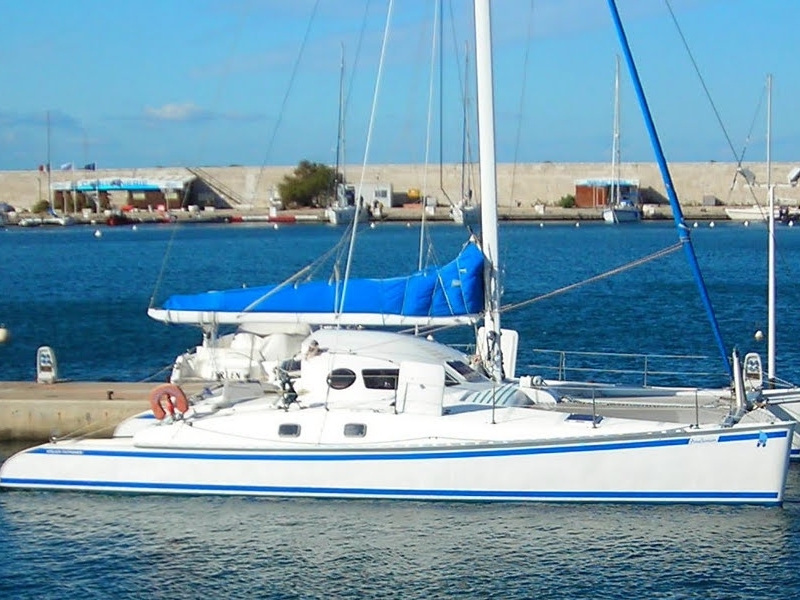
In 2010, after Gerard Danson’s death, a redesigned Outremer 49 was launched. The design was inspired by the original design tenets, but the hulls got wider (read: slower), the cabintop became a little larger and less aerodynamic, and more creature comforts were added. Saildrives replaced the drive shafts. Modern looking fine entry plumb bows replaced stronger blunted bows and a more traditional shear line of the original. I have a feeling that Mr.Danson might see many of these design choices as comprises in speed and seaworthiness for more comfort and curb appeal. Modernization also brought speed-worthy improvements. Foam core construction is used throughout the boat to save weight, including all of the cabinetry. Carbon fiber reinforcement was standard at the chain plates. Outremer added optional carbon upgrades to the bulk heads, bimini, mast and longeron. There was even a rotating carbon mast option which can increase sail efficiency by as much as 15%. Square top mainsails were also optional, and you could ditch those old school stainless stays for kevlar or carbon. The Outremer 49 was Sail magazine’s boat of the year in 2012.
Outremer 49
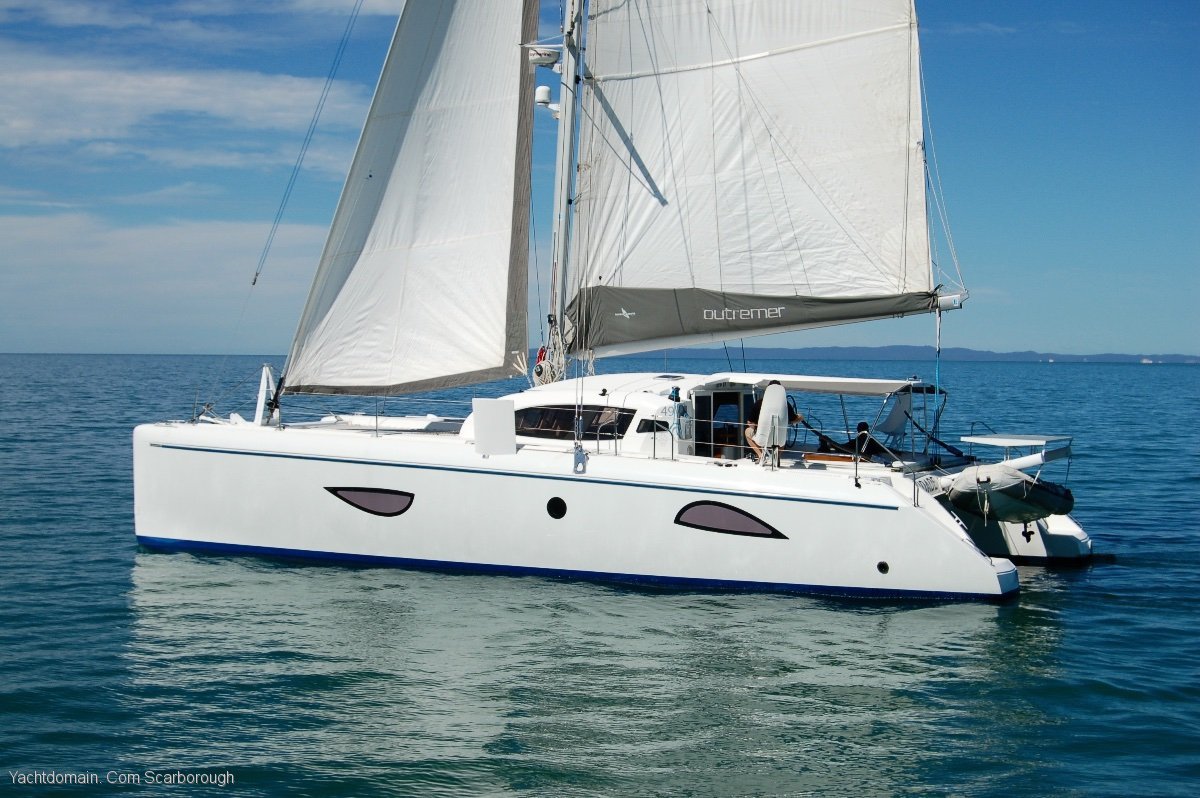
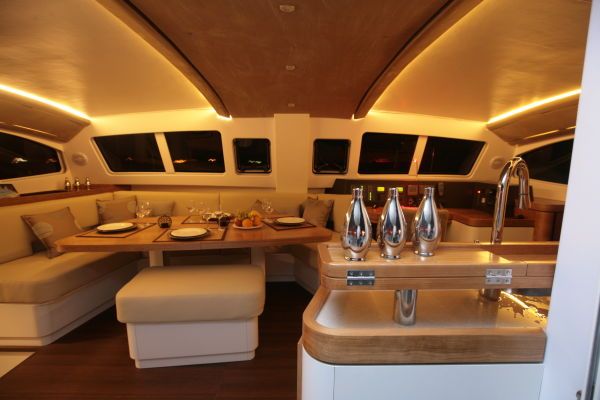
In 2013, the 49 became the 51, sugar scoops on the transom extended the waterline. The 49’s Funky tear drop cabin windows were replaced with ovaloid rectangular windows. The house change to look more like the flag ship 5X model, and the interior saloon was redesigned. The Outremer 51 water line was further increased with reverse shear bows. Extending the bows put floatation forward and helps the boat keep its bows up in heavy weather. The Outremer 51 went through another design revision later, the most noticeable design change are long swooping chines that run the length of outside of the hulls.
2015 Outremer 51
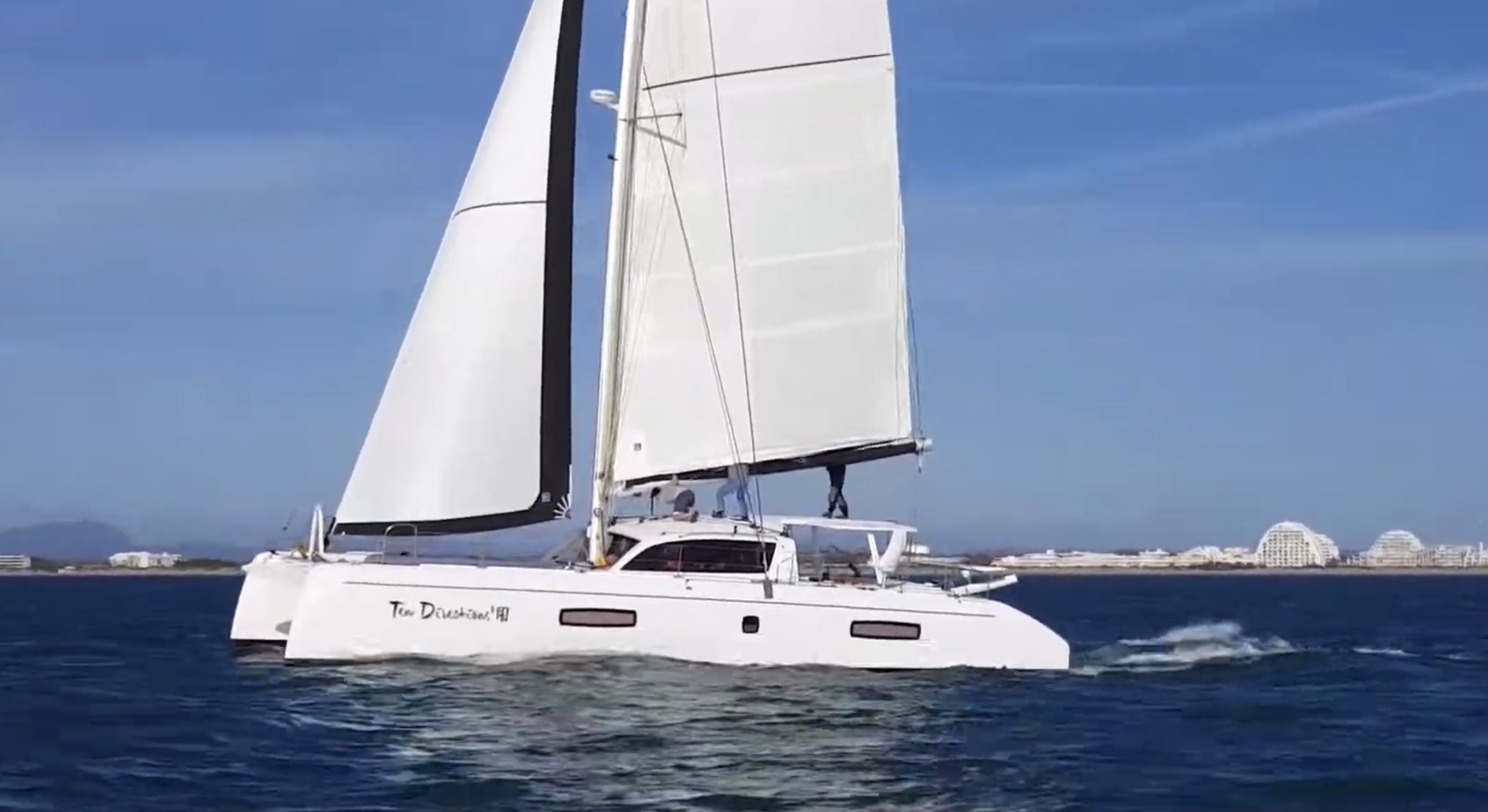
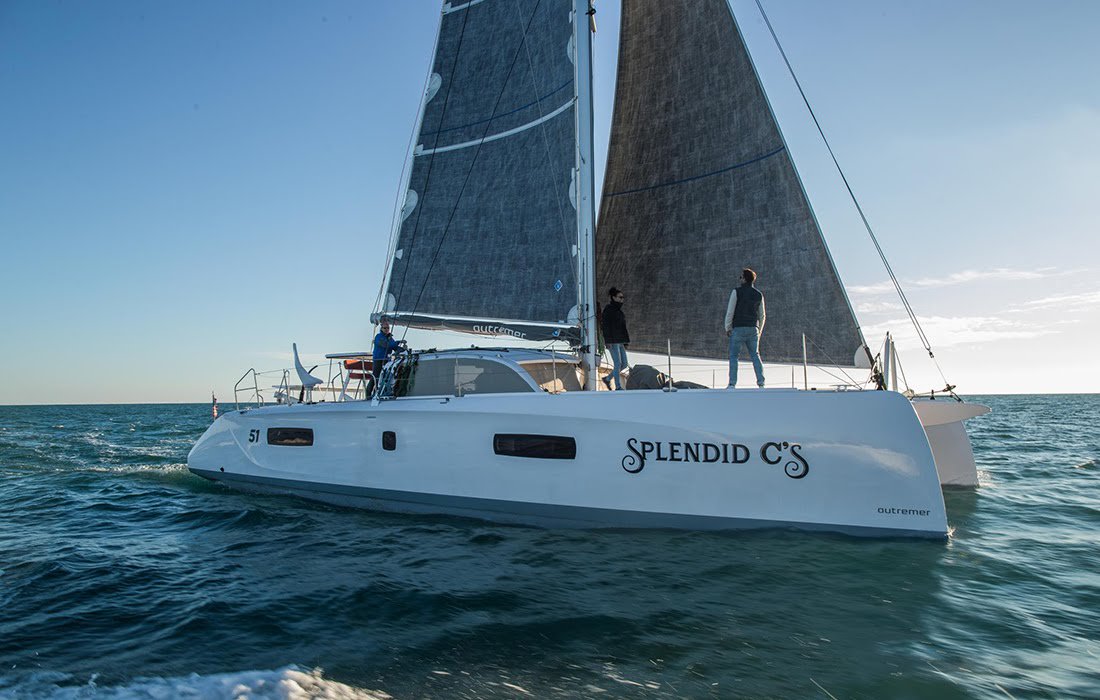
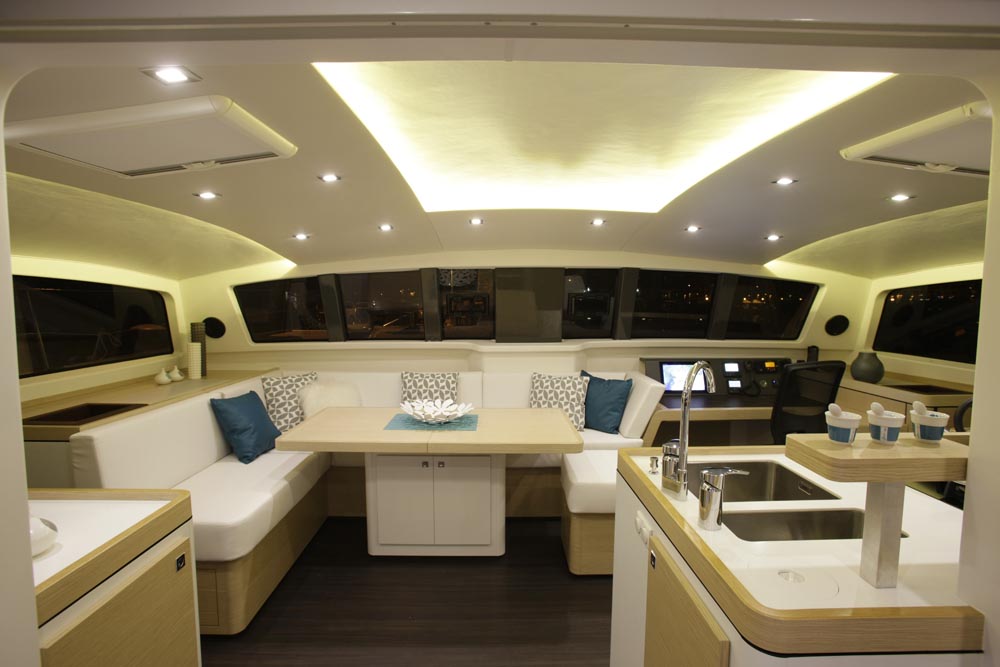
Life as Ten Directions
The ten directions are the eight points of the compass (north, south, east, west, northeast, northwest, southeast and southwest) and the directions of up and down (zenith and nadir), in which different manifestations of Buddha exist.
We learned at survey that this boat probably came out of the O49 molds, then the bows were cut off, and new reverse shear bows were installed. The joint seams are visible in the forward lockers. The boat was originally equipped with the carbon fiber longeron option. The longeron could support a staysail, but this boat is solent rigged with no staysail. She was also built with carbon fiber bulkheads, which saves some 595lbs of weight and adds additional stiffening. The cockpit has a carbon fiber hard Bimini. The optional carbon tillers and steering wheel were added, as well as a square-top main, a code-0 and a code-D. She is not rigged with the optional genoa. Ten Directions has a 75’ tall aluminum rig. The original owners had not opted for the fixed carbon or rotation carbon mast option, perhaps because insurers were declining to cover carbon rigs due to increased risk of lightning strike damage. Aluminum rigs can survive a strike, but carbon not so much. Speaking of lightning, Spice was originally outfitted with lightning protection with conductive ribbon running through the mast and down to sintered bronze plates on the outside of each hull below the waterline. Spice has a Spectra water maker and two electric flushing heads. Spice has the owner’s hull configuration, which means the port hull has a queen size owners cabin in the stern and a large head in the bow. The other hull features a cabin in the bow and stern, a head forward midships and a shower aft midships.
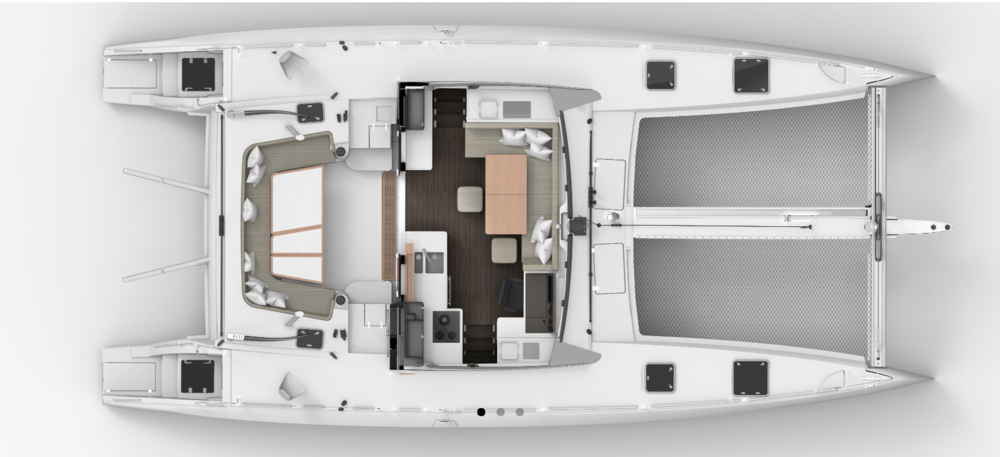
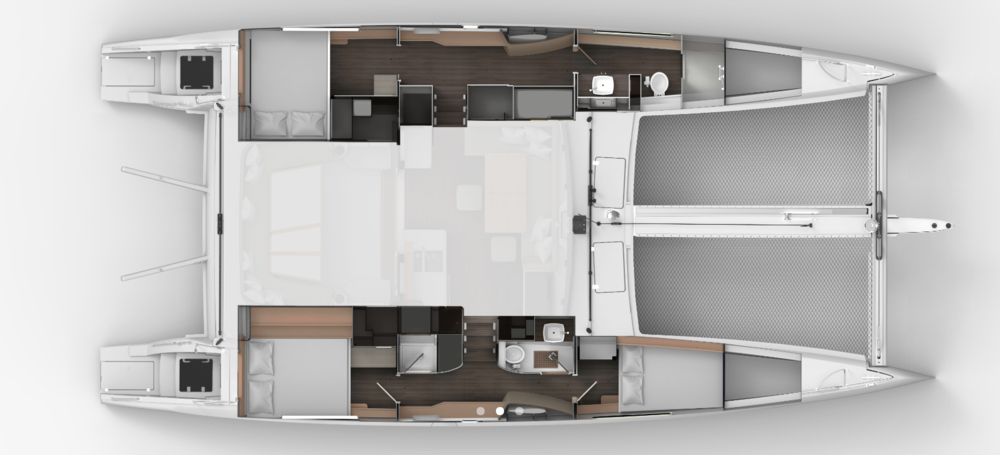
The hard bimini was modified with larger cut-aways to make more head room when stepping down into the cockpit from the deck. They also added a full sunbrella and isinglass enclosure to the cockpit. We don’t know much history prior to the last owner, other than they likely did some cruising in the Med and then brought Ten Directions over to the east coast of the united states. She may have done a bit of cruising in the Caribbean and was brought through the Panama canal to her second owner.
Life as Eight Directions
Eight is a lucky number. We suspect this is the reason the second owner got rid of two of the original ten directions and renamed the boat Eight Directions.
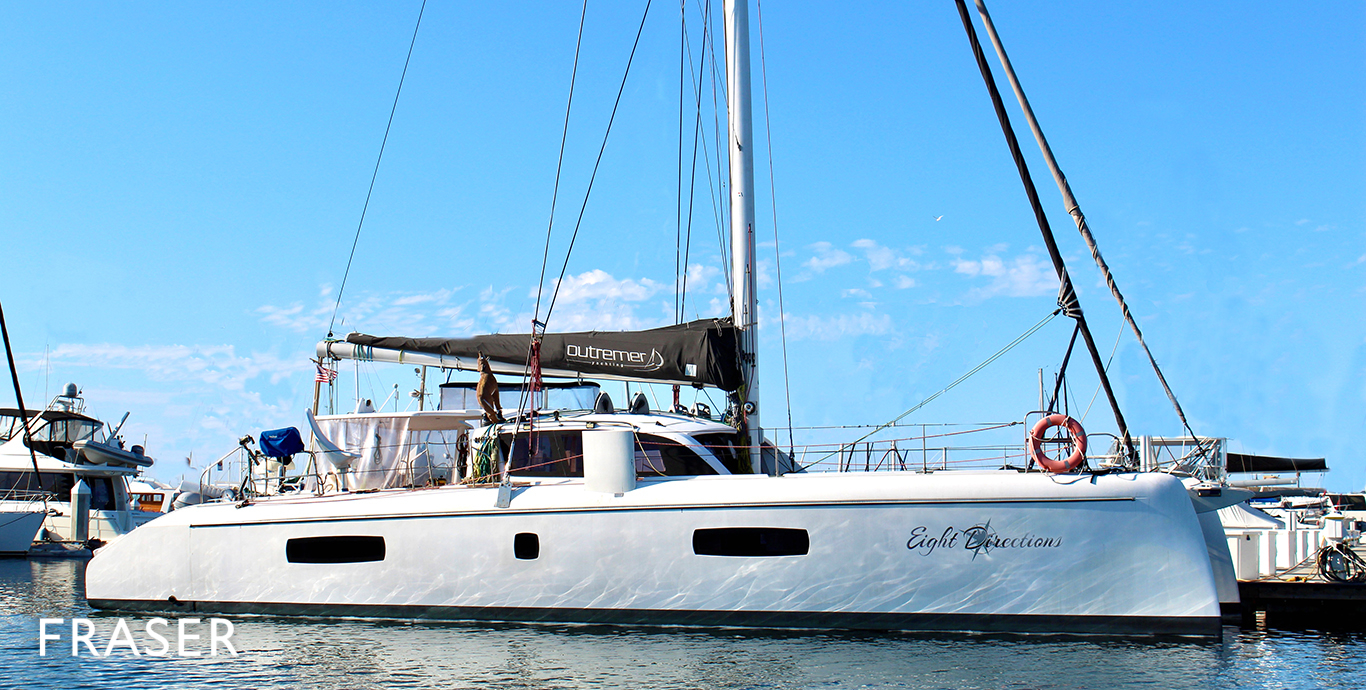
Rumor has it that the second owner anticipated a major world-wide pandemic and wanted a boat that could get his family out of the country if and when a pandemic struck. COVID-19 struck while the second owner was out of country, separated from his family. Sadly, he wasn’t able to make use of his escape pod. Though the escape pod plans fell through, the ships logs show the second owner got a lot of use out of Spice. He learned to sail on Spice and liked to sail fast. He often single-handed her. Spice is a damned big boat for learning to sail, and single-handing on top of that! The boat made a number of day sailing excursions and even weekend trips to Catalina island and down to Mexico.
The second owner made a number of changes and upgrades. The solar panel over the dingy davits was removed, and a 600W Watt & Sea hydro generator was added. The electrical system was upgraded. The original AGM batteries and Master Volt system was entirely replaced with a Victron system with lithium ion batteries. The prior owner also installed 6 electric winches. I initially scoffed at the winches, but I have really come to appreciate them. They make single and double handing much easier. The system allows me to control all six winches from the helm position, giving me six extra sets of hands. The second owner also replaced the original cockpit table with a much smaller and lighter Indian rosewood and foam core carbon fiber table. The whole table probably weighs 5 lbs. A gallows was added on top to securely cradle the boom when lowered to rest on top of the hard bimini. The second owner also added a color-coded jiffy reefing system for the main. The factory black-water holding tanks in the bilge were replaced with larger holding tanks in each of the bow lockers.
Boat was also outfitted with many toys, including fishing and scuba gear, and a new gas grill mounted to the push pit. There were lots of lights for squid jigging and night fishing. The boat also came with safety gear, including 4 gumby suits, a very complete offshore medical kit and a hand operated water maker. The scuba gear included a couple full size tanks, many pony bottles and a few sets of regs, fins and masks.
When I went down for boat survey, we found the boat in good condition. She was in need of a full buff and wax. The gelcoat was matted out due to the southern California sun. The owner had recently replaced both Volvo engines due to a recall. Both engines had low hours. In the prior haulout, she got a new coat of bottom paint. While she was out for survey, the seals on the saildrives where replaced. There was hard-blistering along the bow joints and along the bottom of the hull at the hull joint. They painted over the blisters in the last haul out. We spent a lot of time trying to sort out the root cause. A bit a scraping with a knife revealed dry fairing compound. The consensus theory is that the fairing compound didn’t get enough cure time before it was sealed. We can expect more blisters over the next year or so along the hull joints. At some future haul out, we may choose to grind out and replace the compound to get a fair bottom. But there is no need to worry about water intrusion. While the boat was on the hard, my broker and I took the opportunity to tune and tighten the rudder linkage. We took out a bit of sloppiness in the steering and aligned the rudders. Everything else was ship shape with only a few minor findings in the survey.
Now Spice
Our plans for spice include adding nearly 2.4kwatts of solar. The largest of three arrays will be installed on a custom stainless steel arch over the dinghy davits. We have already installed a new reverse cycle air conditioner Heater Install , replaced and upgraded the 120 to 240 volt step up transformer which we use to power the newly installed compact clothes washer. The main, jib, code 0 and code d are in decent enough shape. The code d lost its head on the delivery, but it has since been repaired and the luff reinforced with a dyneema line. As much as I’d like to fit the boat with a set of 3Dis, it will have to wait. I do plan to order a North Sails G2 asymmetric spinnaker rigged with a 3 tackline system to enable us to fly the sail off of the longeron or off of either bow. We have a new helm seat on order, and plans to repair and upgrade some of the sunbrella cockpit enclosure.
3d scan of the house and bimini with proposed solar arch.
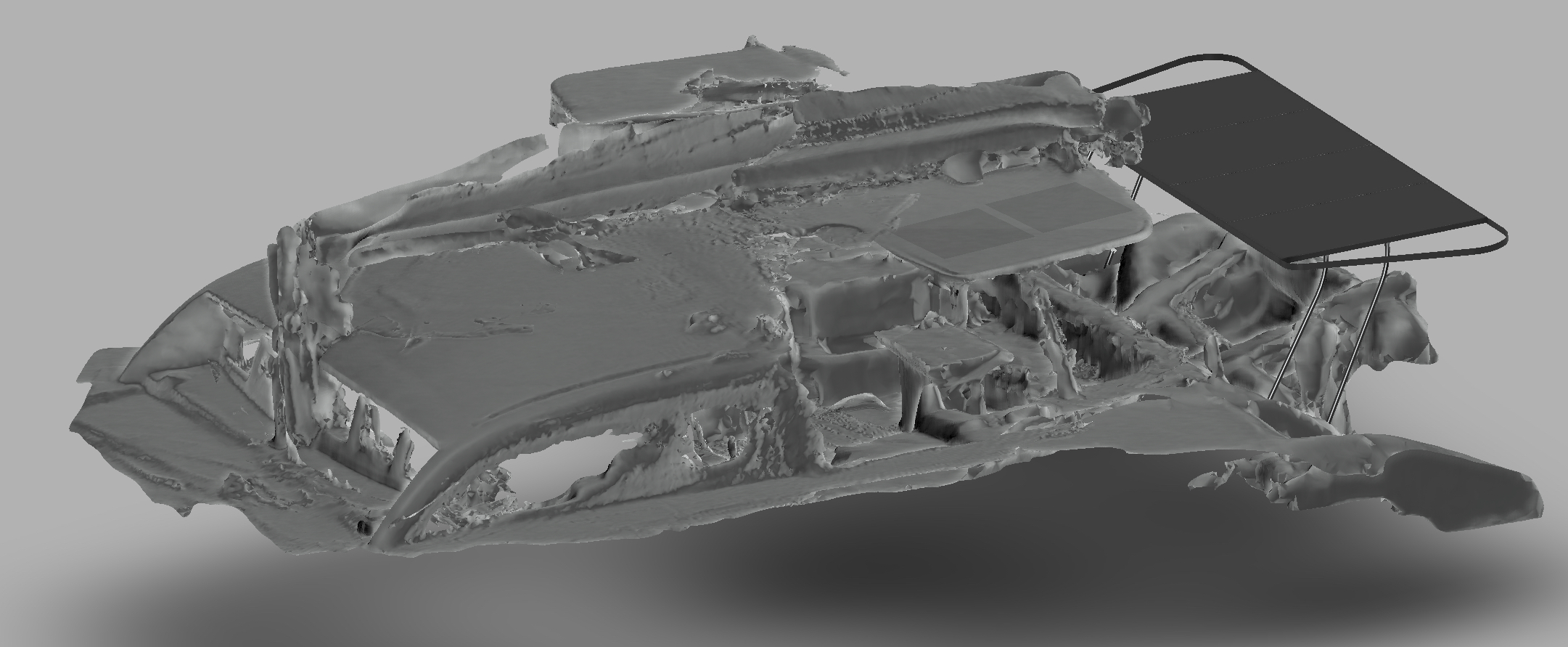
Once she is outfitted, Spice will start out cruising the Salish Sea. Hopefully included a trip up to Desolation Sound. Then around August of 2022, we will head south to California to visit friends and family before setting off for our 5 year circumnavigation.
